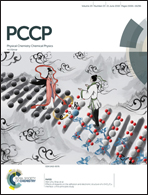A critical assessment of force field accuracy against NMR data for cyclic peptides containing β-amino acids†
Abstract
Hybrid cyclic α/β-peptides, in which one or more β-amino acids are incorporated into the backbone, are gaining increasing interest as potential therapeutics, thanks to their ability to achieve enhanced binding affinities for a biological target through pre-organization in solution. The in silico prediction of their three dimensional structure through strategies such as MD simulations would substantially advance the rational design process. However, whether the molecular mechanics force fields are accurate in sampling highly constrained cyclopeptides containing β-amino acids remains to be verified. Here, we present a systematic assessment of the ability of 8 widely used force fields to reproduce 79 NMR observables (including chemical shifts and 3J scalar couplings) on five cyclic α/β-peptides that contain the integrin recognition motif isoDGR. Most of the investigated force fields, which include force fields from AMBER, OPLS, CHARMM and GROMOS families, display very good agreement with experimental 3J(HN,Hα), suggesting that MD simulations could be an appropriate tool in the rational design of therapeutic cyclic α-peptides. However, for NMR observables directly related to β-amino acids, we observed a poor agreement with experiments and a remarkable dependence of our evaluation on the choice of Karplus parameters. The force field weaknesses herein unveiled might constitute a source of inspiration for further force field optimization.



 Please wait while we load your content...
Please wait while we load your content...